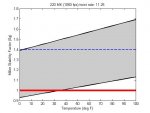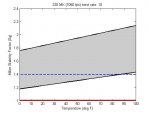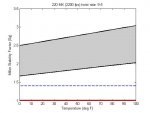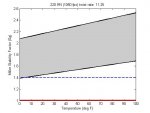The question of bullet stability is not the same thing as accuracy of the load. Did the bullets go straight through the paper? Did they go sideways through the paper? If they punched straight through then they are stable. If you see large oval shaped or bullet profile shaped holes then they are unstable.
You make an important distinction between the two. Although, in my limited experience, there is a correlation there. it would be difficult to get an unstable bullet to perform consistently (accurately) at range. Similarly, a stable bullet would exhibit some degree of consistency/accuracy...not necessarily sub-moa but hopefully better than 10 MOA.
I can't speak to the bullets' orientation when they impacted steel at 400yds. I can tell you that in my 9.5 twist gas gun the 220s going 2200fps hit 400yd steel (18") less than 10% of the time, and POI was up to 3' off POA in all directions; 1 o'clock, 8 o'clock, 5 o'clock etc. That led me to believe the bullets were already tumbling early in their flight. The test 208's all hit the steel, which would be tough to do if they were completely unstable. I'm still in load dev but I have 208 AMAXs around 1.5 MOA (at 200) with no keyholes, around 2175fps. With the 220s I wouldn't even be able to get them on the paper.
Idiot warning: not proud of the following but I have to tell the truth...
The piston gun was at the smiths for a while, they worked on it and shot it some to confirm accuracy was at least moa. I got it back and just shot it. Once I got to 200 rds (plus whatever the smith did) and the chamber started looking dirty I took it apart this weekend and found the op rod was bent. It was still cycling on the last round fired, a Lapua D46 going 2424. I have no idea when the rod bent. It could have been when I had mild pressure signs with the 220s (mild cratering/wipe/ejector marks etc). gas port was on lowest setting (suppressor setting). New rod is in the mail today and I'll pay closer attention during load dev, taking it out for inspection between recipes.
Now for the strangest part of all.
I had 40 or so 220s left, no hope of shooting them in the 9.5 twist and no other rifle that could use them.
I happened to copper clean my 26" 1:12 700 SPS Varmint last week and I wanted to copper foul the barrel Sunday. I figured the massive bearing surface on the 220s would shed more copper per shot than anything else I had, and they were essentially useless to me, so I decided to load up 10 of them to copper up my barrel. I took advantage of the Remington's endless freebore and loaded them long at 2.976, still about 30 thou off the lands.
I expected them to shoot even worse than they did in the 9.5 twist, which as stated above was minute of barn. I guessed 11 MOA elevation at 400yds. Expecting to see a big dirt splash several feet from POA, I hit steel. 6 out of 7. So I went to paper at 400 to print a group with the last 3 and they were just over MOA, no keyholes. MV was around 2360 with no pressure signs.
I know barrel twist is not always an exact science, but I did not expect my 1:12 to stabilize 220 SMKs.







